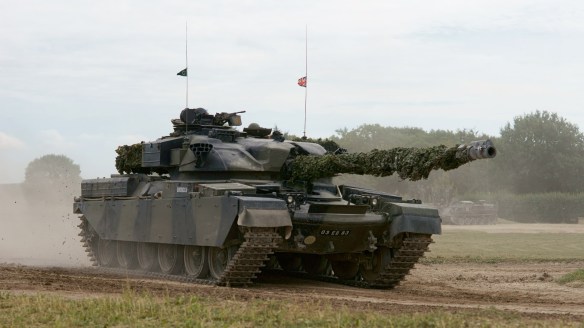Mark 10 upgrade, searchlight replaced with the Thermal Observation and Gunnery System (TOGS), manufactured by Barr and Stroud.
The Mk 11 was the last version to be used by the British Army and can be distinguished by its Stillbrew armour (attached to the front of the turret and in front of the turret ring) and TOGS (thermo-optical gunnery system) camera and cooling unit attached to the left hand side of the turret and replacing the massive spot light used on previous marks.
Its weight was approximately 55 tons, it was armed with the L11A5 120mm rifled gun (together with a coax. and cupula 7.62 MG) and had a top speed of 48km/h.
In the 1960s the production of Chieftain tanks was split between the Vickers factory and the Royal Ordnance factory in Leeds. The full re-equipment of B.A.O.R. with Chieftains was substantially completed by 1972. It had been the policy of successive Governments to look first to the Royal Ordnance Factories for heavy armoured fighting vehicles, and in lean times this means that tank production work must go to the Royal Ordnance Factory at Leeds. This was the most efficient procedure as far as defence votes are concerned, as it avoided the excessive overhead costs that would arise from maintaining two sources of supply. It was sensible that the production of these tanks should be concentrated at one factory, and it was concentrated at Leeds. The decision was taken in the light of a comparison in 1970 of the costs at the two potential sources of production.
By 1979 some 1,600 engineering workers in the defence division of Vickers were anxiously awaiting decisions by the Government on new armaments orders, including an order for 77 Chieftain tanks for Vickers at Elswick which negotiated the tender. At the beginning of 1979 the Army Board considered it a matter of urgency that 77 Chieftain tanks should be ordered to bring the war maintenance reserve for the British Army of the Rhine up to date. The board accepted the request and treated it as a matter of urgency. The Government pulled out all the stops. Vickers Limited tendered and the tender was found acceptable. Had it not been for the general election, the order would have been given to Vickers and the tanks would have been produced at the Elswick works in Newcastle upon Tyne. But by June 1980 the order still had not been placed with Vickers on Tyneside.
A variety of fire control systems and thermal sights were available for Chieftain. Some 324 Chieftains were upgraded with the Barr and Stroud TOGS thermal sight system. The 1R26 thermal camera can be used with the 1R18 thermal night sight. It has wide (13.6°) and narrow (4.75°) fields of view, and is compatible with TOGS format. GEC Sensors offers a long list of sights including: Multisensors Platform, Tank Thermal Sensor, and SS100/110 thermal night sight. Marconi, Nanoquest, and Pilkington offer day and night sights for the Chieftain.
Charm Armament upgrade program, with the 120-mm L30 gun incorporated in Challenger 1, was available for Chieftain modification programs. The work to consider a replacement fire control system for Chieftain started before the 1987 Canadian gunnery competition.
Chieftain entered service with the British Army in 1965. Although it continues to give excellent service, over time it advanced in years, and technology in this field moved ahead. It proved impracticable to organise an international collaborative tank project in an early time scale. Allied collaboration in tanks and their armament remains an important objective for the future; but by the late 1980s Chieftain must be replaced as soon as practicable by a tank developed nationally by the UK or an ally.
As of 1991 the Government’s intention was to re-equip completely two regiments of Chieftains. It was believed that after the Options arrangements were fully in place, there would remain two regiments of Chieftains. They will be replaced with the new Challenger 2 tank. The numbers in this contract would be up to about 130, which is larger than required to equip two regiments but included tanks for training and logistical support.
